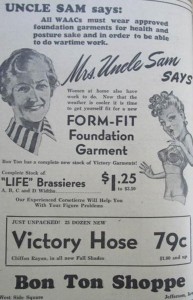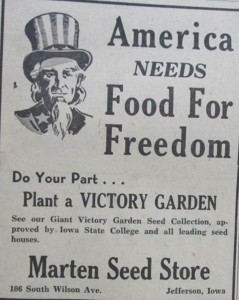Historical Society has special program Sunday, Nov. 8, about that challenging era
With the end of World War Two 70 years ago this fall, Greene County residents hoped their lives would return to normal. Along with the rest of the U.S.A., they had prayed and pitched in on the “Home Front” for four long years.
The war had affected every single one of the 16,600 people – men, women and children of all ages – then in the county.

The story of their Home Front effort will be told in a program presented by the Greene County Historical Society Sunday, Nov. 8, at 2 pm at the group’s museum at 219 E. Lincoln Way in Jefferson. The program will be free and open to the public.
Mikki Schwarzkopf and Denise O’Brien Van will present the program, which will include visuals and exhibits created by Historical Society secretary Janet Durlam and volunteer Dianne Piepel.
They’ll inform and entertain with stories of how Greene County coped with rationing and shortages; of how local citizens responded to the draft and to news of soldiers in harm’s way far from home; how local farmers fed the Armed Forces and the Home Front; how housewives made thousands of bandages for the Red Cross and stretched their food budgets; and how kids pitched in, collecting not only paper and scrap metals, but milkweed silk used in life jackets.
 Schwarzkopf found that children often didn’t realize how the war affected their families. Don Goodrich of Jefferson was a young teenager who had two older brothers who were pilots. He was drying dishes one night for his mother, and looked up to see her crying. Why? The song “Comin’ In On a Wing and a Prayer” was playing on the radio.
Schwarzkopf found that children often didn’t realize how the war affected their families. Don Goodrich of Jefferson was a young teenager who had two older brothers who were pilots. He was drying dishes one night for his mother, and looked up to see her crying. Why? The song “Comin’ In On a Wing and a Prayer” was playing on the radio.
Schwarzkopf was also surprised to learn that Jefferson’s town whistle began blowing every day at 7 a m because of the shortage of alarm clocks.
Van said one of “the most interesting things to me was that the people on the Home Front pitched in and did what the government required of them to help win the war by supplying the Armed Forces. There were restrictions on how much sugar and meat could be purchased from local grocers. Tires and gasoline were rationed and it was impossible to buy new farm machinery. There were few complaints.
 “The war changed Greene County in so many ways,” Van continued. “We became an agricultural powerhouse as the government pushed for increased crop and livestock production. And the soldiers home from overseas, many of whom had never traveled beyond Iowa, brought the influences of their experiences and of other cultures back with them.”
“The war changed Greene County in so many ways,” Van continued. “We became an agricultural powerhouse as the government pushed for increased crop and livestock production. And the soldiers home from overseas, many of whom had never traveled beyond Iowa, brought the influences of their experiences and of other cultures back with them.”
Schwarzkopf and Van spent months researching and writing the project, reading more than 500 issues of the Jefferson Bee and Herald, interviewing local citizens who lived through the war years and roaming the Internet to find additional information. Durlam found hundreds of newspaper photos and ads to illustrate the program, and searched the museum’s collection for World War Two artifacts which she and Piepel arranged for display.
“I’m sure this program will bring back memories for many people,” Durlam says. “And it will enlighten younger folks about how Greene County’s Home Front ‘Greatest Generation’ helped win the war.”
Durlam’s son and daughter-in-law Zack and Eryn Durlam, who are singers and teachers in Milwaukee, WI, have recorded a number of favorite WWII songs that will be played during the program.
